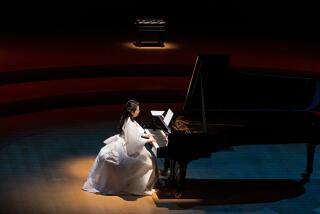Poetic Pianism of Thibaudet
LAGUNA BEACH â The concert, given by Jean-Yves Thibaudet at Laguna Beach High Schoolâs Artistsâ Theater, was offered as a collaboration between the Philharmonic Society of Orange County and the AIDS Services Foundation of Orange County, so his opening piece--âPavane pour une infante defunte,â by Ravel--held particular poignancy. But the pianist, who lives in both his native France and in New York, heightened the effect Thursday night by looking at the work through a remarkable prism of quiet colors.
This ability to filter scores through an unusual awareness of shades and moods imbued Thibaudetâs recital with an aura of classy sensuality, even in pieces like Lisztâs showy but schlocky Ballade No. 2, in B minor, in which the idea of romantic storytelling took preeminence over its demonic thunderings and heroic octaves.
Except perhaps for the Ballade, the program seemed chosen with his unique sensitivity and delicate control in mind. Thibaudet sandwiched transcriptions of Bill Evansâ âWaltz for Debbyâ and âTurn Out the Starsâ among five works by Ravel--the pavane, âJeaux dâeauâ and three selections from âMiroirsâ--luxuriating in the harmonic flights of each and indulging in harp-like pointillism.
He presented a set of Nocturnes, by Chopin, as shared intimacies, studies in light and tone, focused and meditative, and brought a discriminating awareness of voicing and purpose to fluid performances of the first and third etudes, from the Opus 25 set, and of the âRevolutionaryâ Etude. He explored the concept of cantabile in the singing portions of Lisztâs Concert Paraphrase from Verdiâs âRigoletto.â
Thibaudet had peppered his agenda with enough technical razzle-dazzle to bring any audience to its feet--cascades of impressionistic passage work, three of Chopinâs most popular etudes, fistfuls of Lisztâs chordal fireworks. He jumped through all the hoops with ease, and the audience did rise to its feet; one hopes the response was not prompted by the acrobatics, but by the poetic goals they so consistently served.
âLâIsle joyeuseâ and âClair de lune,â by Debussy were the encores, each played with rich, urgent sensuousness.
More to Read
The biggest entertainment stories
Get our big stories about Hollywood, film, television, music, arts, culture and more right in your inbox as soon as they publish.
You may occasionally receive promotional content from the Los Angeles Times.










